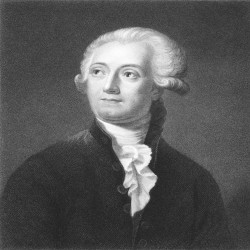
Antoine Lavoisier
French chemist
| Date of Birth | : | 26 August, 1743 |
| Date of Death | : | 08 May, 1794 (Aged 50) |
| Place of Birth | : | Paris, France |
| Profession | : | Chemist |
| Nationality | : | French |
French chemist (ফরাসি রসায়নবিদ) also Antoine Lavoisier after the French Revolution, was a French nobleman and chemist who was central to the 18th-century chemical revolution and who had a large influence on both the history of chemistry and the history of biology.
Biography
It is generally accepted that Lavoisier's great accomplishments in chemistry stem largely from his changing the science from a qualitative to a quantitative one. Lavoisier is most noted for his discovery of the role oxygen plays in combustion. He recognized and named oxygen (1778) and hydrogen (1783), and opposed the phlogiston theory. Lavoisier helped construct the metric system, wrote the first extensive list of elements, and helped to reform chemical nomenclature. He predicted the existence of silicon (1787) and discovered that, although matter may change its form or shape, its mass always remains the same.
Lavoisier was a powerful member of a number of aristocratic councils, and an administrator of the Ferme générale. The Ferme générale was one of the most hated components of the Ancien Régime because of the profits it took at the expense of the state, the secrecy of the terms of its contracts, and the violence of its armed agents. All of these political and economic activities enabled him to fund his scientific research. At the height of the French Revolution, he was charged with tax fraud and selling adulterated tobacco, and was guillotined. Antoine-Laurent Lavoisier was born to a wealthy family of the nobility in Paris on 26 August 1743. The son of an attorney at the Parlement of Paris, he inherited a large fortune at the age of five upon the death of his mother.[8] Lavoisier began his schooling at the Collège des Quatre-Nations, University of Paris (also known as the Collège Mazarin) in Paris in 1754 at the age of 11. In his last two years (1760–1761) at the school, his scientific interests were aroused, and he studied chemistry, botany, astronomy, and mathematics. In the philosophy class he came under the tutelage of Abbé Nicolas Louis de Lacaille, a distinguished mathematician and observational astronomer who imbued the young Lavoisier with an interest in meteorological observation, an enthusiasm which never left him. Lavoisier entered the school of law, where he received a bachelor's degree in 1763 and a licentiate in 1764. Lavoisier received a law degree and was admitted to the bar, but never practiced as a lawyer. However, he continued his scientific education in his spare time.
Early scientific work
Lavoisier's education was filled with the ideals of the French Enlightenment of the time, and he was fascinated by Pierre Macquer's dictionary of chemistry. He attended lectures in the natural sciences. Lavoisier's devotion and passion for chemistry were largely influenced by Étienne Condillac, a prominent French scholar of the 18th century. His first chemical publication appeared in 1764. From 1763 to 1767, he studied geology under Jean-Étienne Guettard. In collaboration with Guettard, Lavoisier worked on a geological survey of Alsace-Lorraine in June 1767. In 1764 he read his first paper to the French Academy of Sciences, France's most elite scientific society, on the chemical and physical properties of gypsum (hydrated calcium sulfate), and in 1766 he was awarded a gold medal by the King for an essay on the problems of urban street lighting.[9] In 1768 Lavoisier received a provisional appointment to the Academy of Sciences. In 1769, he worked on the first geological map of France.
Quotes
Total 0 Quotes
Quotes not found.